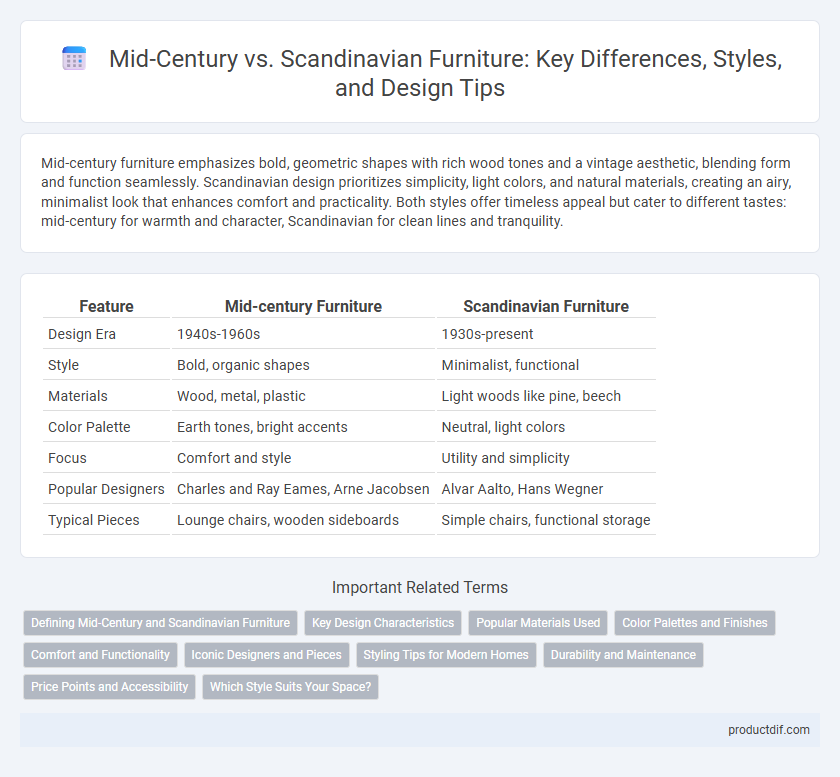Mid-century furniture emphasizes bold, geometric shapes with rich wood tones and a vintage aesthetic, blending form and function seamlessly. Scandinavian design prioritizes simplicity, light colors, and natural materials, creating an airy, minimalist look that enhances comfort and practicality. Both styles offer timeless appeal but cater to different tastes: mid-century for warmth and character, Scandinavian for clean lines and tranquility.
Table of Comparison
| Feature | Mid-century Furniture | Scandinavian Furniture |
|---|---|---|
| Design Era | 1940s-1960s | 1930s-present |
| Style | Bold, organic shapes | Minimalist, functional |
| Materials | Wood, metal, plastic | Light woods like pine, beech |
| Color Palette | Earth tones, bright accents | Neutral, light colors |
| Focus | Comfort and style | Utility and simplicity |
| Popular Designers | Charles and Ray Eames, Arne Jacobsen | Alvar Aalto, Hans Wegner |
| Typical Pieces | Lounge chairs, wooden sideboards | Simple chairs, functional storage |
Defining Mid-Century and Scandinavian Furniture
Mid-century furniture is characterized by clean lines, organic curves, and functional design, often using teak and walnut woods that emphasize simplicity and natural beauty. Scandinavian furniture highlights minimalism, light tones, and practical forms with an emphasis on craftsmanship and sustainable materials like pine and birch wood. Both styles prioritize functionality and sleek aesthetics but differ in their color palettes and material choices, reflecting mid-century warmth versus Scandinavian lightness.
Key Design Characteristics
Mid-century furniture features clean lines, organic curves, and a mix of traditional and non-traditional materials such as wood, metal, and plastic, emphasizing functionality and simplicity. Scandinavian design prioritizes minimalist aesthetics, light colors, natural materials like pine and oak, and a focus on comfort and functionality with an airy, bright appearance. Both styles highlight craftsmanship, but mid-century often includes bold shapes and vibrant upholstery, while Scandinavian leans toward understated elegance and neutral tones.
Popular Materials Used
Mid-century furniture commonly features teak, walnut, and rosewood, prized for their durability and rich grain patterns, often complemented by leather and metal accents for a sophisticated touch. Scandinavian designs emphasize light woods like birch, pine, and oak to create airy, minimalist aesthetics, frequently paired with natural textiles such as linen and wool to enhance comfort and simplicity. Both styles prioritize high-quality, sustainable materials that highlight craftsmanship and timeless appeal.
Color Palettes and Finishes
Mid-century furniture typically features warm, earthy tones such as walnut, teak, and rich browns, complemented by matte or satin finishes that highlight natural wood grains. Scandinavian design emphasizes light, neutral color palettes including whites, soft grays, and pastel hues, often paired with smooth, matte finishes to create a clean, airy atmosphere. Both styles prioritize simplicity but differ in color vibrancy and surface textures, with mid-century offering warmth and Scandinavian promoting brightness.
Comfort and Functionality
Mid-century furniture emphasizes a balance of comfort and functionality through its use of ergonomic designs, plush cushions, and durable materials such as teak and walnut, making it ideal for relaxed living spaces. Scandinavian furniture prioritizes minimalism and practicality with lightweight structures, clean lines, and multifunctional elements that enhance space efficiency without sacrificing comfort. Both styles deliver comfort and functionality but cater to different aesthetic preferences and spatial needs.
Iconic Designers and Pieces
Mid-century furniture, defined by designers like Charles and Ray Eames, George Nelson, and Hans Wegner, features iconic pieces such as the Eames Lounge Chair, Nelson Bench, and Wegner's Wishbone Chair, blending organic shapes with functional design. Scandinavian furniture emphasizes simplicity, minimalism, and craftsmanship, highlighted by Arne Jacobsen's Egg Chair and Alvar Aalto's bentwood chairs, showcasing natural materials and clean lines. Both styles prioritize ergonomic comfort and timeless aesthetics, influencing modern furniture design globally.
Styling Tips for Modern Homes
Mid-century furniture emphasizes organic shapes, tapered legs, and warm wood tones, creating a cozy yet sophisticated atmosphere in modern homes. Scandinavian design highlights minimalism, light colors, and natural materials like birch and leather, promoting a clean and airy aesthetic. Combining these styles can balance warmth and simplicity, using mid-century statement pieces alongside Scandinavian functional accessories for a harmonious living space.
Durability and Maintenance
Mid-century furniture, often crafted from solid wood like teak or walnut, is renowned for its durability and resistance to wear, requiring occasional polishing to maintain its finish. Scandinavian designs emphasize simplicity with lighter woods such as pine or birch, offering ease of cleaning and low maintenance but may be less resilient to heavy use over time. Both styles provide practical solutions, with mid-century favoring longevity and Scandinavian prioritizing minimal upkeep.
Price Points and Accessibility
Mid-century furniture typically features higher price points due to its vintage appeal and iconic designer origins, making it less accessible for budget-conscious buyers. Scandinavian furniture offers more affordable options with minimalist design and functional aesthetics, widely available through popular retailers and online stores. Both styles emphasize quality craftsmanship, but Scandinavian designs prioritize accessibility without compromising on style.
Which Style Suits Your Space?
Mid-century furniture features bold lines, organic shapes, and warm woods that complement spacious, eclectic interiors with vintage flair. Scandinavian design emphasizes minimalist aesthetics, light colors, and functional pieces ideal for small, airy spaces needing a calm, uncluttered atmosphere. Choosing between the two depends on your room size, natural light, and desire for either a cozy retro vibe or a modern, minimalist look.
Mid-century vs Scandinavian Infographic

 productdif.com
productdif.com